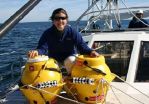(Press-News.org) DALLAS - Dec. 16, 2014 - It's a sound that saves. A "real-time" radiation monitor that alerts by beeping in response to radiation exposure during cardiac-catheterization procedures significantly reduces the amount of exposure that medical workers receive, UT Southwestern Medical Center researchers found.
In a randomized study, the researchers divided 505 patients undergoing either diagnostic coronary angiography or percutaneous coronary intervention, such as stent placement, into two groups. In half the procedures, medical workers used the current gold standard for radiation monitoring, which is a "dosimetry" badge that is worn by a medical worker for a month and then sent off for the cumulative radiation dose to be read. In the other half, medical workers wore a device called Bleeper Sv, which beeps approximately once every 15 minutes in response to low background radiation, and beeps once every 20 seconds when exposure is higher, or continuously, if it is very high.
In settings where the medical workers wore the device that gives the real-time auditory feedback, radiation exposure was consistently decreased by approximately one-third.
"Radiation is invisible," said Dr. Emmanouil Brilakis, Associate Professor of Internal Medicine at UT Southwestern and senior author of the paper. "Use of a radiation detection device can provide real-time 'visualization' of radiation exposure, enabling operators to take actions to reduce radiation exposure."
Among actions that medical workers can take to reduce radiation exposure are reducing the frame rate (the number of X-ray images taken per second to create a "movie" of the coronary arteries), decreasing fluoroscopy time, repositioning the patient, repositioning the medical worker, adjusting the position of the radiation shield, and using additional shielding.
"Using devices that provide real-time radiation-exposure feedback can help the operator adopt safer radiation practices," said Dr. Brilakis, who is also Director of the Cardiac Catheterization Laboratories at the VA North Texas Health Care System. "In our study, this was achieved in a real-life setting among unselected patients using a low-cost device that can be used with any X-ray system."
Physicians and other medical workers on cardiac-catheterization teams will likely participate in hundreds of procedures a year. The dose limit for occupational exposure is 20 mSv per year for five years, but no dose is safe and all doses are considered to contribute to cancer risk.
"It has been shown that people who are chronically exposed to radiation in cardiac catheterization labs are more likely to develop left-sided brain tumors," said Dr. Brilakis. "The reduction in operator exposure observed in our study is likely to translate into a decreased risk for long-term adverse clinical events."
The results of the RadiCure study appear in the Dec. 16 issue of Circulation: Cardiovascular Interventions.
Other UT Southwestern researchers involved in this study are Dr. Anna Kotsia, Postdoctoral Researcher; Bavana V. Rangan, Research Scientist; Michele Roesle, RN; Dr. Atif Mohammad, Senior Research Associate; and Dr. Subhash Banerjee, Associate Professor of Internal Medicine.
This study is supported by the Department of Veterans Affairs and the Dallas VA Research Corp. Dr. Banerjee received research grants from Gilead and the Medicines Company. Dr. Banerjee received consultant/speaker honoraria from Covidien and Medtronic, has ownership in MDCARE Global and intellectual property in HygeiaTel. Dr. Brilakis received honoraria/speaker fees from St. Jude Medical, Terumo, Asahi, Abbott Vascular, Somahlution, Elsevier, and Boston Scientific. He has a research grant from Guerbet.
About UT Southwestern Medical Center
UT Southwestern, one of the premier academic medical centers in the nation, integrates pioneering biomedical research with exceptional clinical care and education. The institution's faculty includes many distinguished members, including six who have been awarded Nobel Prizes since 1985. Numbering approximately 2,800, the faculty is responsible for groundbreaking medical advances and is committed to translating science-driven research quickly to new clinical treatments. UT Southwestern physicians provide medical care in 40 specialties to about 92,000 hospitalized patients and oversee approximately 2.1 million outpatient visits a year.
INFORMATION:
This news release is available on our home page at
http://www.utsouthwestern.edu/home/news/index.html
To automatically receive news releases from UT Southwestern via email,
subscribe at http://www.utsouthwestern.edu/receivenews
Boston, MA-- Nutrition experts are continually debating the nutritional value of carbohydrate-containing foods and whether some are healthier than others. High carbohydrate foods are classified by how much they increase blood sugar; known as glycemic index. In new findings led by researchers at Brigham and Women's Hospital (BWH) in Boston and Johns Hopkins University (JHU) in Baltimore, researchers looked at glycemic index' effect on cardiovascular disease (CVD) and diabetes and found that low glycemic diets did not improve insulin sensitivity or cardiovascular risk factors. ...
HOUSTON - (Dec. 16, 2014) - Rice University scientists have detected at least three instances of cross-species mating that likely influenced the evolutionary paths of "old world" mice, two in recent times and one in the distant past.
The researchers think these instances of introgressive hybridization -- a way for genetic material and, potentially, traits to be passed from one species to another through interspecific mating -- are only the first of many needles waiting to be found in a very large genetic haystack. While introgressive hybridization is thought to be common ...
By analyzing data on multilingual Twitter users and Wikipedia editors and on 30 years' worth of book translations in 150 countries, researchers at MIT, Harvard University, Northeastern University, and Aix Marseille University have developed network maps that they say represent the strength of the cultural connections between speakers of different languages.
This week, in the Proceedings of the National Academy of Sciences, they show that a language's centrality in their network -- as defined by both the number and the strength of its connections -- better predicts the ...
PRINCETON, N.J.--More than half of all American children will likely live with an unmarried mother at some point before they reach age 18, according to a report issued by Princeton University and Harvard University.
The absence of a biological father increases the likelihood that a child will exhibit antisocial behaviors like aggression, rule-breaking and delinquency, the researchers report in the journal EducationNext. This finding - which holds true regardless of a child's race - is especially prevalent among young boys. As a result, these children are 40 percent less ...
We humans have an exceptional age structure compared to other animals: Our children remain dependent on their parents for an unusually long period and our elderly live an extremely long time after they have stopped procreating.
Could the microscopic fellow travelers that consider the human body to be their home - collectively known as the microbiome - have played an active role in shaping and maintaining this unusual aspect of human nature?
That is the speculative proposition advanced by Martin Blaser, professor of medicine and microbiology at NYU's Langone Medical ...
Humpback whales have a trick or two, when it comes to finding a quick snack at the bottom of the ocean. But how they pinpoint that meal at night, with little or no available light, remains a mystery.
Susan Parks, assistant professor of Biology in Syracuse University's College of Arts and Sciences, in collaboration with a consortium of other researchers, has been studying these unique feeding behaviors. Her research emphasizes the importance of specific auditory cues that these mammoth creatures emit, as they search the deep ocean for their prey.
Her findings are the ...
Massachusetts General Hospital (MGH) investigators have developed a method of detecting, across the entire genome of human cells, unwanted DNA breaks induced by use of the popular gene-editing tools called CRISPR-Cas RNA-guided nucleases (RGNs). Members of the same team that first described these off-target effects in human cells describe their new platform, called Genome-wide Unbiased Indentification of DSBs Evaluated by Sequencing (GUIDE-seq), in a report being published online in Nature Biotechnology.
"GUIDE-seq is the first genome-wide method of sensitively detecting ...
ANN ARBOR--A national survey of students in U.S. middle schools and high schools shows some important improvements in levels of substance use.
Both alcohol and cigarette use in 2014 are at their lowest points since the study began in 1975. Use of a number of illicit drugs also show declines this year.
These findings come from the University of Michigan's Monitoring the Future study, which tracks trends in substance use among students in 8th, 10th and 12th grades. Each year the national study, now in its 40th year, surveys 40,000 to 50,000 students in about 400 secondary ...
The rate at which carbon emissions warmed Earth's climate almost 56 million years ago resembles modern, human-caused global warming much more than previously believed, but involved two pulses of carbon to the atmosphere, researchers have found.
The findings mean that the so-called Paleocene-Eocene thermal maximum, or PETM, can provide clues to the future of modern climate change.
The good news: Earth and most species survived.
The bad news: It took millennia to recover from the episode, when temperatures rose by 5 to 8 degrees Celsius (9 to 15 degrees Fahrenheit). ...
Researchers at Columbia University's Mailman School of Public Health analyzed the results of the Oregon Health Experiment, where eligible uninsured individuals were randomly assigned Medicaid or to stay with their current care. Considered controversial because the experiment found no measurable gains for physical health it did reveal benefits for mental health, financial wellbeing, and preventive screening. In terms of quality-adjusted life years, the researchers showed that Medicaid is an excellent value--a $62,000 gain in quality-adjusted life years. Study findings are ...




